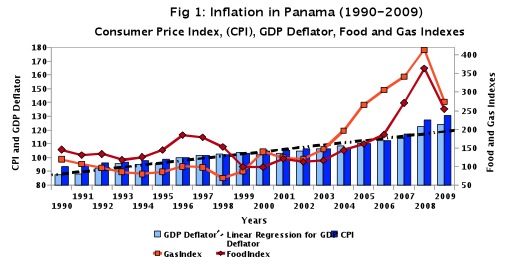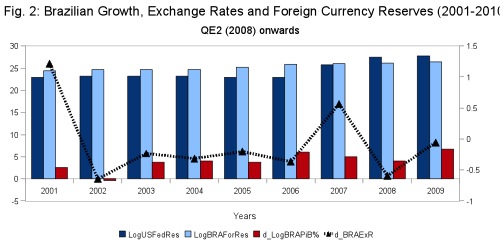Strauss-Kahn’s Visit to Latin America: A New Economic Policy?
President Obama is not the only world figure who has headed south recently. During the first week of March, director-general of the International Monetary Fund (IMF), Dominique Strauss-Kahn, visited Latin America. During his fast-moving tour across Panama, Uruguay and Brazil, he sought to highlight some of the policies being implemented in the region in the wake of the recent global financial crisis.
For the most part, Latin America has managed to fend off the brunt of the world economic downturn by avoiding the West’s prescriptions—costly errors of yesteryear—featuring canned formulas and impositions by international financial institutions and the developed world that were so popular during the nineties. By all accounts, Latin American countries, even before the global crisis set in, took a realist, home-grown perspective about how to maintain sustainable growth and avoid the financial contagion which later spread to other regions of the developed world.
Panama
In a blog post which prologued his tour, Stauss-Kahn quickly pointed out that buoyant economic growth, along with rising commodity prices, could challenge prospects for a “soft landing” of the region, or a scenario where policymakers are able to fend off an inflationary crisis and tame growth to a more manageable level. Without a doubt, Panama, one of the countries on his tour, is a case in point. Although he commends the Panamanian government’s commitment in paying down its debt to allow for more fiscal policy space—a welcome strategy that was undertaken by both the current Martinelli administration as well as the past Torrijos presidency—Strauss-Kahn, to one’s serious regret, fails to mention the inflationary challenges which are slowly creeping up in that country.
Figure 1 below shows the dynamics of inflation in Panama: Given its dollarized economy, Panama had a benign experience with price spikes—to the point that price levels abroad were on the decline between 2000 and 2005. Over the past twenty years, inflation in the country averaged 2%, well below the 3.2% benchmark for the United States over the same period. However, the country witnessed a dramatic increase in inflation beyond the trend (the black dotted line), and what is even worse, a split between narrow and broad inflation gauges.
The graph above shows the difference between the Consumer Price Index, in dark blue, a narrow measurement of the price level of a basket of basic goods, and the GDP deflator, in light blue. The last cited figure is a broader measure of the price level being registered by the economy, which increased over 2008 and 2009. Responsibility for the inflation spike and split between the two is manifest in the overall increase in costs of food (in red). A likely suspect for this recent inflation surge, it could be the “push” being strongly felt in the price level with respect to other rising costs (like gas, in orange).
Added to increased demand from a burgeoning middle class in Asia, the strengthening monopolies in the fields of distribution and production of agricultural commodities have prompted further markups to the already increasing cost, which are affecting the poor disproportionally via the restricted measure afforded by the CPI. Cash constrained and with less ability to substitute goods, the poor are vulnerable and, so far, are suffering the brunt of the price spikes, a dangerous recipe for allowing instability to develop. Right now Panama is experiencing a volatile political climate; the political detonator was a controversial mining law that allowed an international consortia to prospect for minerals in the indigenous-populated regions of the country. But as the recent unrest in Egypt and Tunisia indicated with clarity, rising food prices and stagnant incomes deepen a crisis which many commentators breezily dismissed in the beginning.
Presently, the Panamanian government is grossly ill-prepared to deal with rising prices. The country’s institutional mechanisms are at a loss of an ability to determine which policy tools could tame inflation; it can only actively devise social programs to help lower the price of goods to a sizable and vulnerable citizenry. Its institutions (like the National Institute for Agricultural Marketing) and programs (like the Compita program for the distribution of subsidized goods to vulnerable populations) lack the resources to adequately face these challenges and, as of late, such efforts have had to be scaled back. Even more disheartening, President Martinelli’s relatively rare innovative idea was intent on creating a national secretariat to handle the distribution of frozen goods across the country, which could allow for lower prices between production and distribution outlets. This strategy has now stalled due to technical difficulties and all but impassable bureaucratic red tape.
Brazil
Nonetheless, not all is doom-and-gloom: Strauss-Kahn will stop in Brazil, a country whose prodigious clout has risen in the past few years on the international scene and which many believe represents the promise of the region’s future. As the director of the IMF, his visit could very well mark a change in the history of that institution, which has now shifted its rhetoric from the extreme narrative of liberalization to a more careful and reasoned stance on allowing for capital controls and the introduction of government intervention—a kinder approach that some experts see as an early attempt to possibly attract further international goodwill for a possible run for the French presidency.
Yet, Brazil is under pressure: it was the country’s finance minister, Guido Mantega, who coined the term “currency wars” last year, when a number of countries started to defend their own monetary systems in the wake of QE2 and the U.S. Federal Reserve Bank restarted a massive buyout of bonds to push their yields down and with it, re-float prices, investment and levels of consumption. Figure 2 below tells that story.
The bar shows the reserves (scaled in logs) at the banks which constitute part of the Federal Reserve System (in dark blue), the foreign currency reserves (in dollars, scaled in logs) at the Brazilian Central Bank, as well as the growth rate of that country’s economy (in red) along with the difference in that country’s exchange rate one year prior (the black-dotted line).
From the bar chart we can see how the Federal Reserve policy changes dramatically in 2008 due to its intervention in the market to buttress distressed banks—yet Brazilian foreign market intervention stayed pretty much the same. The problem was that Brazil had little policy space in order to increase its already huge foreign currency reserves, given the massive intervention of the Fed. The Brazilian exchange rate, which slumped during the 2002 down cycle, later recovered when the economy showed signs of picking up again and remained stable until 2008, when the Fed’s action caused investors to begin to lose confidence in the dollar’s strength. Brazil tried to correct market sentiment by increasing its exposure to the currency, but given its massive dollar reserves, it could not take on the task in the face of the Fed’s power to credit accounts with its “printing press” capacity. As of late, Brazilian reais have started to appreciate, given the growth prospects of the economy—indeed, cheaper imports and a large government economic footprint could drive up the tempo of a consumer credit market already in overdrive.
For this reason, Brazil has had almost no choice but to opt for “strengthening macro-prudential financial regulations,” as Strauss-Kahn put it: to stem the flow of hot money, given higher available interest rates. To do this, it instituted a currency conversion tax applied to equity and debt investments by foreigners in the Brazilian stock exchanges and over-the-counter markets. Also, it raised the margin requirements for those institutions that are shorting (or betting against) the dollar, hoping to borrow, sell and buy back the currency at a lower rate. All this seeks to ease the inflationary pressures facing the economy, without shutting down eager investors.
The Rebirth of Strategic Policy: Brazil Will Lead the Way
Brazil is showing the way, and Latin America is very likely to follow. Although it had to plow through a complicated history, economic orthodoxy was never deeply entrenched in Brazil. Pragmatism triumphed after the traumatic shift towards the real in 1994, which ended Brazilian hyperinflation. At that time, a bias towards macroeconomic prudence became the norm—both the Cardoso and the Lula da Silva administrations set the standards. Yet Lula sought to pursue an agenda beyond tough-minded macroeconomics and tilt the scale towards development, implementing ambitious social programs like Bolsa Família and a massive investment push regarding infrastructure and education, which hopefully will serve the needs of a growing cohort of middle-class citizens as Lula had hoped. Without a doubt, Brazil still has a long way to go, but being a trailblazer is seldom easy.
Meanwhile, Brazil is banking on its policy of prudence, “currency wars” aside. The return of what were until very recently “heterodox” policies like capital controls (in contrast to more conventional free-wheeling capital accounts) is highlighting the need to focus on development and on stability of national economic interests in the context of strategic plans. Liberalization must be done smartly, taking into account its overall costs, in order to secure its benefits without harming the poor. Like Strauss-Kahn tells us: policymakers work against hard landings not for their own sake, but to “sustain strong growth for generations to come, as well as to allow the fruits of growth to be shared across all members of society.”
For this reason, policymakers and politicians in vulnerable countries like Panama must be more ambitious in their commitment to transform outdated institutions and strengthen safety nets in order to allow for economic growth and development. Careful thought must be given in trying to establish what is the best way to allow for public-private partnerships to provide for these spaces – only then will Latin America be able to sustain its accomplishments, and be proud of the long road it has travelled in order to assert its increasingly impressive position internationally.



